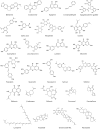Role of PD-1/PD-L1 signaling axis in oncogenesis and its targeting by bioactive natural compounds for cancer immunotherapy
- PMID: 39690423
- PMCID: PMC11654217
- DOI: 10.1186/s40779-024-00586-9
Role of PD-1/PD-L1 signaling axis in oncogenesis and its targeting by bioactive natural compounds for cancer immunotherapy
Abstract
Cancer is a global health problem and one of the leading causes of mortality. Immune checkpoint inhibitors have revolutionized the field of oncology, emerging as a powerful treatment strategy. A key pathway that has garnered considerable attention is programmed cell death-1 (PD-1)/programmed cell death ligand-1 (PD-L1). The interaction between PD-L1 expressed on tumor cells and PD-1 reduces the innate immune response and thus compromises the capability of the body's immune system. Furthermore, it controls the phenotype and functionality of innate and adaptive immune components. A range of monoclonal antibodies, including avelumab, atezolizumab, camrelizumab, dostarlimab, durvalumab, sinitilimab, toripalimab, and zimberelimab, have been developed for targeting the interaction between PD-1 and PD-L1. These agents can induce a broad spectrum of autoimmune-like complications that may affect any organ system. Recent studies have focused on the effect of various natural compounds that inhibit immune checkpoints. This could contribute to the existing arsenal of anticancer drugs. Several bioactive natural agents have been shown to affect the PD-1/PD-L1 signaling axis, promoting tumor cell apoptosis, influencing cell proliferation, and eventually leading to tumor cell death and inhibiting cancer progression. However, there is a substantial knowledge gap regarding the role of different natural compounds targeting PD-1 in the context of cancer. Hence, this review aims to provide a common connection between PD-1/PD-L1 blockade and the anticancer effects of distinct natural molecules. Moreover, the primary focus will be on the underlying mechanism of action as well as the clinical efficacy of bioactive molecules. Current challenges along with the scope of future research directions targeting PD-1/PD-L1 interactions through natural substances are also discussed.
Keywords: Cancer; Crosstalk; Natural compounds; PD-1/PD-L1; Therapeutic targets.
© 2024. The Author(s).
Conflict of interest statement
Declarations. Ethics approval and consent to participate: Not applicable. Consent for publication: Not applicable. Competing interests: The authors declare that they have no competing interests.
Figures






Similar articles
-
Exploring immune checkpoint inhibitors: Focus on PD-1/PD-L1 axis and beyond.Pathol Res Pract. 2025 May;269:155864. doi: 10.1016/j.prp.2025.155864. Epub 2025 Mar 1. Pathol Res Pract. 2025. PMID: 40068282 Review.
-
Study and analysis of antitumor resistance mechanism of PD1/PD-L1 immune checkpoint blocker.Cancer Med. 2020 Nov;9(21):8086-8121. doi: 10.1002/cam4.3410. Epub 2020 Sep 2. Cancer Med. 2020. PMID: 32875727 Free PMC article. Review.
-
Combination strategies with PD-1/PD-L1 blockade: current advances and future directions.Mol Cancer. 2022 Jan 21;21(1):28. doi: 10.1186/s12943-021-01489-2. Mol Cancer. 2022. PMID: 35062949 Free PMC article. Review.
-
Small molecule inhibitors targeting the PD-1/PD-L1 signaling pathway.Acta Pharmacol Sin. 2021 Jan;42(1):1-9. doi: 10.1038/s41401-020-0366-x. Epub 2020 Mar 9. Acta Pharmacol Sin. 2021. PMID: 32152439 Free PMC article. Review.
-
Modulation of N-glycosylation in the PD-1: PD-L1 axis as a strategy to enhance cancer immunotherapies.Biochim Biophys Acta Rev Cancer. 2025 Apr;1880(2):189274. doi: 10.1016/j.bbcan.2025.189274. Epub 2025 Jan 26. Biochim Biophys Acta Rev Cancer. 2025. PMID: 39875060 Review.
Cited by
-
Navigating the role of protein lactylation in prostate cancer and its implications for immunotherapy.J Cancer. 2025 Jun 12;16(8):2706-2719. doi: 10.7150/jca.114137. eCollection 2025. J Cancer. 2025. PMID: 40535811 Free PMC article. Review.
-
Application of Immune Checkpoint Inhibitors in Cancer.MedComm (2020). 2025 Aug 10;6(8):e70176. doi: 10.1002/mco2.70176. eCollection 2025 Aug. MedComm (2020). 2025. PMID: 40787068 Free PMC article. Review.
-
Tumor treating fields enhance anti-PD therapy by improving CCL2/8 and CXCL9/CXCL10 expression through inducing immunogenic cell death in NSCLC models.BMC Cancer. 2025 Mar 17;25(1):489. doi: 10.1186/s12885-025-13859-w. BMC Cancer. 2025. PMID: 40098106 Free PMC article.
-
Exploring microRNA targeting as a promising approach for solid tumor treatment.Front Oncol. 2025 Jul 21;15:1570093. doi: 10.3389/fonc.2025.1570093. eCollection 2025. Front Oncol. 2025. PMID: 40761244 Free PMC article. Review.
-
Lactylation-related gene signatures identify glioma molecular subtypes with prognostic, immunological, and therapeutic implications.Front Oncol. 2025 Jul 16;15:1613423. doi: 10.3389/fonc.2025.1613423. eCollection 2025. Front Oncol. 2025. PMID: 40740857 Free PMC article.
References
-
- Vaghari-Tabari M, Ferns GA, Qujeq D, Andevari AN, Sabahi Z, Moein S. Signaling, metabolism, and cancer: an important relationship for therapeutic intervention. J Cell Physiol. 2021;236(8):5512–32. - PubMed
-
- Siegel RL, Giaquinto AN, Jemal A. Cancer statistics, 2024. CA Cancer J Clin. 2024;74(1):12–49. - PubMed
-
- Mao JJ, Pillai GG, Andrade CJ, Ligibel JA, Basu P, Cohen L, et al. Integrative oncology: addressing the global challenges of cancer prevention and treatment. CA Cancer J Clin. 2022;72(2):144–64. - PubMed
-
- Cheek DM, Naxerova K. Mapping the long road to cancer. Cell. 2022;185(6):939–40. - PubMed
Publication types
MeSH terms
Substances
LinkOut - more resources
Full Text Sources
Medical
Research Materials
Miscellaneous

